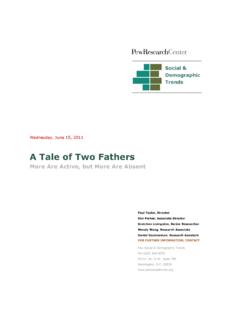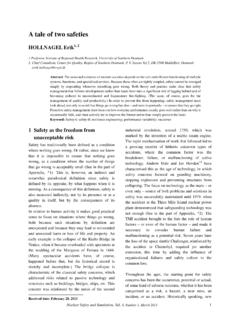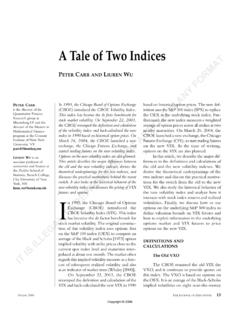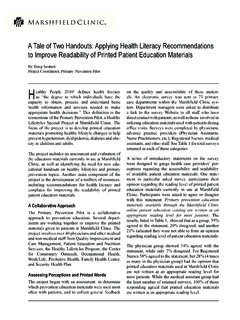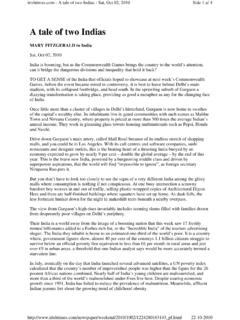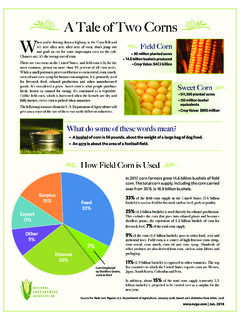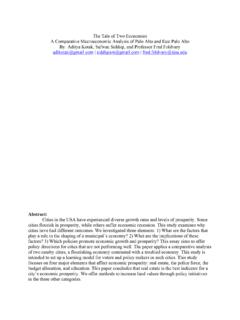Transcription of A TALE OF TWO CALIPHATES - voxpol.eu
1 a tale of two CALIPHATESCOMPARING THE ISLAMIC STATE S INTERNAL AND EXTERNAL MESSAGING PRIORITIES Dounia Mahlouly and Charlie WinterA TALE OF TWO CALIPHATESCOMPARING THE ISLAMIC STATE S INTERNAL AND EXTERNAL MESSAGING PRIORITIESA bout the authorsDr. Dounia Mahlouly is a VOX-Pol postdoctoral Research Fellow at ICSR, King s College London. She completed her PhD in sociology at the University of Glasgow, where she has been teaching Introduction to Online Research Methods . Her thesis investigated the role of social media campaigning in the Tunisian and Egyptian post-revolutionary debates, examining how social media was incorporated into the campaigning strategy of leading political actors competing for power after the 2011 uprisings. She conducted an ethnographic fieldwork in affiliation with the American University in Cairo and contributed to an ESRC cross-country research project co-funded by Google and hosted by the Adam Smith Research Foundation.
2 Dounia is also a part-time research associate for the Open University, where she works as a regional expert for a study commissioned by the British Council and Goethe-Institut in Winter is a Senior Research Fellow at the International Centre for the Study of Radicalisation (ICSR). He studies terrorism and insurgency with a focus on online and offline strategic communication, and is working on a PhD in War Studies at King s College London. Alongside his work at ICSR, which is supported by Facebook as part of the Online Civil Courage Initiative, he is an Associate Fellow at the International Centre for Counter-Terrorism in The Hague and an Associate of the Imperial War Museum Institute in London. Winter s work has been published by Critical Studies in Media Communication, Studies in Conflict and Terrorism, Philosophia, the CTC Sentinel, The Atlantic, War On The Rocks and Jihadology, among others.
3 He holds an undergraduate degree in Arabic from the University of Edinburgh and an MA in Middle East and Mediterranean Studies from King s College would like to thank our friends and colleagues at ICSR, Inna Rudolf and Haid Haid, for their contribution to this : 978-1-873769-70-6 VOX-Pol Network of Excellence, 2018 This material is offered free of charge for personal and non-commercial use, provided the source is acknowledged. For commercial or any other use, prior written permission must be obtained from VOX-Pol. In no case may this material be altered, sold or all other VOX-Pol publications, this report can be downloaded free of charge from the VOX-Pol website: and typeset by Soapbox, TALE OF TWO CALIPHATES3 TABLE OF CONTENTSE xecutive summary 4 Overview 4 Key findings 4 INTRODUCTION 6 LITERATURE REVIEW 8 METHODOLOGY 12 Rumiyah 13Al-Naba 14 CONTENT ANALYSIS 18 FINDINGS 22 Structural analysis 23 Thematic analysis 25 Geographic analysis 34 CONCLUSION 38 REFERENCES 42A TALE OF TWO CALIPHATES4 EXECUTIVE SUMMARYOVERVIEWIn recent years.
4 The media department of the self-proclaimed Islamic State has proven itself to be highly adept at strategic communication. While much research has gone into the group s digital and online capabilities, there remains a significant gap in the knowledge regard-ing its in-country propaganda operations and recognition of this, the following research paper approaches the issue from a different angle, attempting to better understand how and why the group communicates its brand through the lens of two pub-lications al-Naba , its Arabic-language newspaper, which appears to be designed primarily for offline dissemination in the caliphate itself, and Rumiyah, its foreign-language electronic magazine, which has only ever appeared online. Using content analysis to identify and compare each publication s internal (local) and external (global) media priorities over the four-month period between September and December 2016, we develop an empirical evaluation of the group s recent forays into targeted FINDINGSThe Islamic State s publication priorities at the end of 2016 were largely bifurcated its propagandists seemed to want different responses from different audiences, and Rumiyah and al-Naba were particularly demonstrative of this.
5 Structurally, the publications bore only partial resemblance to each other, with Rumiyah privileging lengthier, more discursive ideological content and al-Naba primarily tending to preference briefer tactical news items. The publications were also distinct thematically: Rumiyah s con-tent was significantly more abstract that is, weighted towards a tale of two CALIPHATES5complex political, social and theological issues than that of al-Naba , which shed much more light on present-day military matters than anything else. Al-Naba s conception of jihad was distinctly more pragmatic than that of Rumiyah it focused on real-world concerns rather than ideology, something that could point towards the differing motivations of the Islamic State s in- and ex-theatre supporters.
6 There were significant geographic discrepancies between the two publications, with Rumiyah spending more time discussing events and operations external to Syria and Iraq than al-Naba . This was most apparent in the context of the battle for Mosul, which was entirely absent from the pages of Rumiyah, and regularly front-page news in al-Naba . It appears that each publication was carefully tailored to suit its primary consumer audience in Rumiyah s case, this was the Islamic State s diffuse archipelago of global supporters, and in the context of al-Naba , this was, and continues to be, its in-country TALE OF TWO CALIPHATES61. INTRODUCTIONIn recent years, the media department of the self-proclaimed Islamic State has proven itself to be highly adept at target audience segmenta-tion.
7 Since 2013, its strategists have expertly manipulated their global consumers, steering public opinion and prompting the emergence of misconceptions that continue to hobble counter-extremism policymaking today. For example, while conventional wisdom often holds that Islamic State media revolves around brutality, and brutality alone, the violent films for which it is famous form just a tiny part of its overall propaganda output (Zelin 2015; Winter 2015; Milton 2016). This is far from the only mistake made about its approach to media operations; accompanying it is the unfounded assumption that its propaganda is uniquely geared towards radicalising and recruiting would-be foreign fighters and lone-actor terrorists from outside Syria and Iraq (Frampton et al. 2017; Macnair and Frank 2017).
8 In reality, between 2014 and 2017, Abu Bakr al-Baghdadi s propagandists were just as concerned with attaining and retaining the acquiescence of the people over whom they presided as they were about recruiting from abroad. To this end, they used in-theatre information operations to substitute the dominant news agenda for their own and to paint a picture of a glorious and pious utopia. While it is possible to derive a very rough estimate of the caliphate s local public diplomacy through secondhand reporting, the intricacies of these operations remain elusive. Moreover, the group s Internet propaganda corpus, while abundant, cannot be used as a proxy for the totality of its local communications operations because it is not representative of the whole: tradi-tional media products constitute but one portion of the organi-sation s overall propaganda arsenal.
9 Besides conventional devices like video releases, audio bulletins, and written materials, it has also relied on performative propaganda that is, things like public spectacles, interactions with roaming media officials, and sermons a tale of two CALIPHATES7in mosques for offline influence operations in Syria, Iraq, and elsewhere, and there is no way to evaluate that through the use of open sources this, we approach the problem from a different angle, attempting to better understand how and why the Islamic State communicates in-theatre through the lens of two of its most important publications al-Naba , its Arabic-language newspaper, which appears to be designed primarily for offline dissemination in the caliphate itself, and Rumiyah, its foreign-language electronic mag-azine, which has only ever appeared online.
10 Using content analysis to identify and compare each publication s internal (local) and external (global) media priorities over the four-month period between September and December 2016, we develop an empirical evaluation of how the group engages in target audience differentiation. Our analysis shows that, for all its attempts to appear monolithic, the operational essence of the caliphate varied according to location during the period in question: inside Iraq and Syria, it prioritised tactical, pragmatic, and integration-focused appeals over anything else, whereas, outside its borders , it was more conventionally terroristic in its outlook and operations, seeking instead to agitate, incite and instruct. The report begins with a brief overview of the academic literature on strategic communication and the Islamic State, in which we highlight the relative absence of scholarship exploring the offline dimension of its media operations.

